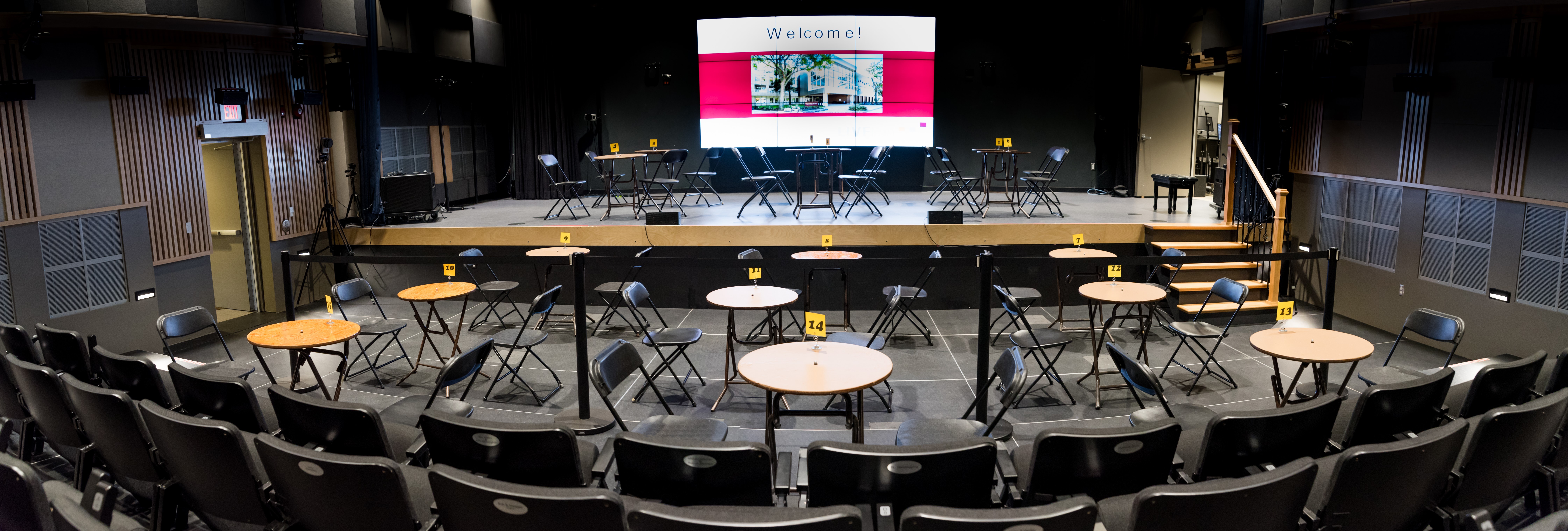The sway of connection

LIVELab's speed dating setup, waiting for participants to arrive
February 14, 2018
When marimba rhythms start to play
Dance with me, make me sway
… Other dancers may be on the floor, dear
But my eyes will see only you
Only you have that magic technique
When we sway I go weak
Turns out Dean Martin got it partly right: moving together as a couple is powerful stuff. According to researchers at the LIVELab at Mac, though, you don’t have to actually dance to experience a connection with a (potentially) special someone.
When two people work together, their body sway – the back and forth movement of the body’s centre of gravity – coordinates. And that coordination is a good measure for a number of indicators that show how two people are getting along: the quality of cooperation, for example, or the flow of information.
Andrew Chang, a fourth-year PhD candidate in the department of Psychology, Neuroscience and Behaviour, has teamed up with Haley Kragness, Anja Thiede, Wei Tsou, LIVELab technical director Dan Bosynak and professor Laurel Trainor to study “interpersonal synchronization” – this natural matching-up of movement between two people engaged in doing something together, whether it’s cooperating to perform a simple task or something a little more … interesting.
“We don’t usually look at romantic relationships,” explains Chang. “What we were interested in at the beginning was how people work together to do something simple, like move an object. From a previous study, we developed a tool that can measure how individuals cooperate with each other based on their body language – more specifically, their body sway.”
Which brought Chang to the idea of speed dating: he’d already looked at other types of interpersonal relationships, but would it be possible to predict whether two people would be interested in dating each other simply by measuring their body sway?
Chang and his team set up two voluntary speed dating events at McMaster’s LIVELab: 15 males and 15 females per night, each of whom would have a four minute “date” with another person before moving on to interact with someone else. Each participant wore a hairband topped with two glowing motion capture markers, which tracked their body sway, while the room was recorded with 25 infra-red cameras.
Participants filled out surveys afterwards on the people they met, including whether they’d be interested in seeking out short- or long-term relationships with one (or more) of them.
And the results weren’t exactly surprising – at least, not for anyone with a passing acquaintance with Dean Martin.
“Body sway is an indication of information flow – who’s listening to whom,” Chang says. “And that can predict how much you want to date someone again – specifically, whether you want to have a long-term relationship with someone.”
In other words, coordinated body sway can be an indicator that two people are having a good conversation – an important quality in a long-term relationship.
While there have been multiple studies showing that physical attractiveness can predict whether people will want both a short- or long-term relationship with someone, no one has measured body sway and speed dating before.
From there, Chang wanted to see if there was a way to encourage coordinated body sway – engineering a connection, rather than simply leaving it to chance.
And for that, he turned to music. Not Dean Martin, but to a specific playlist of “high-groove music” that included Beyonce’s “Nasty Girl,” Stevie Wonder’s “Superstition” and LaBelle’s version of “Lady Marmalade:” all songs with heavy bass and driving rhythm designed to get people dancing.
At each event, half the participants listened to the high-groove music, while the other half heard mellower “low-groove” music, including “Comfortably Numb” by Pink Floyd and “I Will Follow You into the Dark” by Death Cab for Cutie.
And while conventional wisdom might say that the slower, mellower stuff might work better to set a romantic mood, that’s not what happened.
“The percentage of people of people who listened to the low-groove music who wanted to date again was 45 per cent, while the percentage of high-groove listeners who wanted a second date was 50 per cent,” he says. “It’s not the strongest factor in the world, but it indicates that music that encourages coordinated movement can lead to a greater feeling of connection and a greater desire for a second date.”
At this point, of course, these are preliminary findings. The researchers are working on finding out more details about the mechanisms behind the effects they observed.
But for now? On your next date, think about skipping the restaurant with quiet, jazzy piano music in favour of a spot with a little more energy – and figure out some interesting things to talk about.


